Abstract
The livelihood changes due to the COVID-19 policies in low-income and transitional economies serve as a lever for gauging the structural resilience of national food systems. Yet, few studies have addressed the cascading effects of the pandemic policies on the livelihood changes of farming system actors or modeled and provided coherent hypotheses about the transitory structural shifts at the micro-level. Other studies on the subject have either captured the early impacts of the pandemic on food systems with limited or no insight into the sub-Saharan African context or have used macro-level data, due to sparsely available micro-level data. These early insights are relevant for the design of early warning systems. However, an ongoing and deeper insight into the effects of pandemic policies is critical, since new and more comprehensive policies are needed to address the economic fallout and the extenuating effects of COVID-19 on food supply chain disruptions. The overriding questions are as follows: what are the effects of the pandemic policies on the livelihoods of food system actors and are there spatial-economic variations in the effects of the pandemic policies on the livelihoods of the farming system actors? Using 2019 and 2020 primary data from 836 farming system actors in Ghana, we offer fresh insights into the transitory micro-level livelihood changes caused by the COVID-19 anticontagion policies. We analyzed the data using the generalized additive, subset regression, classical linear, and logistic regression models in a machine learning framework. We show that the changes in the livelihood outcomes of the food system actors in Ghana coincide with the nature of pandemic mitigation policies adopted in the spatial units. We found that the lockdown policies had a negative and significant effect on the livelihoods of the farming system actors in the lockdown areas. The policies also negatively affected the livelihoods of the farming system actors in distant communities that shared no direct boundary with the lockdown areas. On the contrary, the lockdown policies positively affected the livelihoods of the farming system actors in the directly contiguous communities to the lockdown areas. We also document the shifts in the livelihood outcomes of the farming system actors, such as income, employment, food demand, and food security in the different spatial policy areas.
1. Introduction
SARS-CoV-2 (COVID-19) and its containment policies continue to impact the livelihoods of food system actors at an unprecedented scale (Carducci et al. 2021; Giwa-Daramola and James 2023; Moseley and Battersby 2020; UN 2023). Ebbing and resurging, COVID-19 amplified the existing livelihood challenges, especially in low- and middle-income countries (Carducci et al. 2021; FAO and WFP 2022; Webb et al. 2021; Giwa-Daramola and James 2023; Moseley and Battersby 2020). SARS-CoV-2 is not a foodborne virus; however, its disruption to socioeconomic factors, food systems, and the everyday life of food system actors has had tremendous repercussions for their income and food and nutrition security (Cable et al. 2020; Dasgupta and Robinson 2022; Webb et al. 2021; Giwa-Daramola and James 2023; UN 2022, 2023).
For instance, COVID-19 reversed approximately three years of global progress on extreme poverty reduction (World Bank 2020; UN 2022, 2023). In 2020, the number of people living in extreme poverty globally, defined as persons living on less than USD 2.15 per day in 2017, purchasing power parity, rose to 724 million, surpassing the pre-pandemic projection by about 90 million (World Bank 2020; UN 2022, 2023). Thus, COVID-19 pushed 93 million additional people into extreme poverty in 2020 (World Bank 2020; UN 2022; 2023). In 2022, about 9.2 percent, or 735 million of the world’s population, faced chronic hunger, which is 122 million more than in 2019 (UN 2023). About 29.6 percent, or 2.4 billion of the world’s population, were moderately or severely food insecure. This estimate of food insecurity reflects an alarming 391 million more people than in 2019 (UN 2023).
The United Nations and its development agencies note that the effects of COVID-19 are far from over. The organization warns that food security may acutely deteriorate further in at least twenty (20) countries, most of which are developing African and Asian countries (FAO and WFP 2022; UN 2022, 2023). The United Nations further warns that the 2030 Agenda for Sustainable Development is in grave jeopardy due to multiple cascading and intersecting crises predominated by COVID-19 (UN 2022, 2023). Despite these stark projections of livelihood changes caused by the COVID-19 pandemic, varying disease burdens and the differential effectiveness of country’s mitigation policies to SARS-CoV-2 across the globe may have differential impact of COVID-19 on national, regional, and local food systems (Dasgupta and Robinson 2022; FAO and WFP 2022; Giwa-Daramola and James 2023; UN 2023).
Thus, even though COVID-19 has consistently resulted in job losses, income shortfalls, and food shortages, the impact of COVID-19 may vary with the different economic structure of countries and the effectiveness of the country’s mitigation policies (Weder di Mauro and Baldwin 2020; Haug et al. 2020; Rose et al. 2021; Trump and Linkov 2020). For instance, large, agrarian-based economies may face different impacts compared to largely industrialized economies (Dasgupta and Robinson 2022; FAO and WFP 2022). Also, some countries adopted stay-in-place restrictions or lockdowns, while others adopted alternative approaches (Weder di Mauro and Baldwin 2020; Haug et al. 2020; Rose et al. 2021). Even among those countries that adopted lockdown COVID-19 anticontagion measures, there were variants, such as partial and complete lockdowns. Two of the unanswered socioeconomic questions that we address in this paper are as follows: what are the structural effects of COVID-19 on the livelihoods of food system actors, and what is the effect of the anticontagion measures on the livelihoods of food system actors?
We answer the above questions using data from farming system actors from Ghana. The Ghana COVID-19 management system provides a case insight into the effects of the COVID-19 anticontagion policy and the structural effects of COVID-19 on the resilience of the food system in a developing country context. Like most sub-Saharan African countries (such as Nigeria, Kenya, Ethiopia, South Africa, and others), at the early phase of the pandemic, selected urban areas in Ghana were under three weeks of mandatory lockdown, with strict policing (Weder di Mauro and Baldwin 2020; Giwa-Daramola and James 2023; Haider et al. 2020; Haug et al. 2020; Rose et al. 2021; Trump and Linkov 2020). In rural and peri-urban areas, the residents were expected to observe social distancing and other COVID-19 preventive protocols, but there were no COVID-19 lockdowns (Haider et al. 2020).
This disparity in the spatial offerings of COVID-19 anticontagion policies across the country may have had varying effects on the livelihoods of the food system actors in the various spatial units. For instance, there were reports of rice piles stuck in northern Ghana, with less defined distribution channels, market, and storage. These disparities in the spatial offerings of the COVID-19 anticontagion policies were also adopted across several sub-Saharan African countries and other developed and developing regions (Weder di Mauro and Baldwin 2020; Giwa-Daramola and James 2023; Haug et al. 2020; Rose et al. 2021; Trump and Linkov 2020). To date, we know very little about the cascading effects of the spatial COVID-19 policy disparities on the livelihoods of the food system actors in these spatial units. However, the food system innovations and consumer lifestyle changes caused by the COVID-19 policies and restrictions may remain, and may even have extenuating effects on consumer and producer behavior at the national and sub-national levels. It is, therefore, imperative to assess the cascading effect of the COVID-19 anticontagion policies on the livelihood of food system actors. In line with this discourse, we seek to understand the structural and location-specific effects of the COVID-19 policies on the incomes and food security of food system actors.
Studies on COVID-19 and the food system are ubiquitous (Aday and Aday 2020; Carducci et al. 2021; Hilchey 2021; Klassen and Murphy 2020; Markandya et al. 2021; Nordhagen et al. 2021). However, most of the studies have captured the preliminary and early impacts of the pandemic on food systems (Aday and Aday 2020; Carducci et al. 2021; Hilchey 2021; Klassen and Murphy 2020; Markandya et al. 2021; Nordhagen et al. 2021). These insights are relevant for the design of early warning systems. However, an ongoing and deeper insight into the effects of COVID-19 has become even more critical, as new, and more comprehensive policies are needed to address the economic fallout and the extenuating effects of COVID-19 on food supply chain disruptions (Laborde et al. 2020; Markandya et al. 2021; UN 2023). Again, several studies have reviewed the COVID-19 effects in different economic geographies, with limited emphasis on the sub-Saharan African context (Béné 2020; Butler et al. 2021; Fan et al. 2021; Galanakis 2020; Ghosh-Jerath et al. 2022; Love et al. 2021; OECD 2021).
Unlike in developed countries, the food security in sub-Saharan Africa was under threat before the COVID-19 pandemic (Barrett 2020; Swinnen and Vos 2021). Also, socio-cultural differences and nuances in the food system operations in sub-Saharan Africa may offer a different context. Thus, these are compelling reasons to understand the effects of COVID-19 on local food systems in sub-Saharan Africa (Barrett 2020; Swinnen and Vos 2021; Giwa-Daramola and James 2023). Again, as the extenuating impact of the pandemic still has some societies in stranglehold, the outcomes remain uncertain, and reliable data are sparsely available, especially from the sub-Saharan African region (Galanakis 2020; OECD 2021; UN 2023). As a result, most of the studies relied on macro-level data and outlooks (Coluccia et al. 2021; Galanakis 2020; Giwa-Daramola and James 2023; Markandya et al. 2021; OECD 2021; Swinnen and McDermott 2020). Our study fills this gap, as we use primary micro-level data to answer the above questions and provide fresh insights into the ravaging livelihood changes of farming system actors from a sub-Saharan African context.
As of October 2020, global governments had invested about USD 12 trillion into COVID-19 economic recovery programs (Markandya et al. 2021). However, the COVID-19 economic recovery programs did not sufficiently address food security and sustainability (Markandya et al. 2021). New policies and programs are necessary in order to address the livelihood challenges and the inequalities and injustices across food systems that have emerged and will prevail post-COVID-19 (Barrett 2020; Gruère and Brooks 2021; Laborde et al. 2020; Markandya et al. 2021). Such food system programs are relevant, particularly for Ghana and sub-Saharan African countries, where agriculture remains a major engine for growth and an avenue for poverty reduction and food security improvement. Disruptions to the food system were caused by COVID-19, therefore, they may have implications for the nearly 60 percent of the population that are directly and indirectly employed in the sector and the overall economies of these countries. The continued disruption of the food system and supply chains and the weak policies and programs that poorly address food policy challenges may also have some implications for social unrest in the already-fragile sub-Saharan African region (Barrett 2020; Giwa-Daramola and James 2023). This research provides guidance and indications for the government of Ghana and other countries across the sub-region to effectively address the unwanted effects of COVID-19 on the food system. The results may also guide the ongoing and future anticontagion policy discourse, design, and implementation, particularly in Ghana. It may also help other, similar low- and middle-income countries to restore and maintain a sustainable food system at national and sub-national levels.
2. Materials and Methods
2.1. Description of the Study Area and Farming Systems
The study was conducted in Ghana. Ghana is a few degrees from the Equator and lies on the Greenwich meridian. Ghana shares boundaries with the Republic of Togo to the east, Burkina Faso to the northwest and north, the Republic of Côte d’Ivoire to the west, and the Gulf of Guinea to the south. In 2021, about 40 percent of the Ghanaian population was employed in the agricultural sector (O’Neill 2023). Agriculture contributed to 18.9 percent of Ghana’s gross domestic product in 2022 (O’Neill 2023). Most of the farming systems in Ghana consist of roots and tubers, cereals, legumes, fruits and vegetables, and tree crops (Danso-Abbeam et al. 2021; FAO 2023; Kuivanen et al. 2016). The staple crops are often mixed-cropped, while the cash crops are usually monocrops (FAO 2023). Tree crop farming systems often involve major crops such as cocoa, oil palm, coffee, and rubber. Food crops are usually intercrops of cereals, such as maize, rice, millet, and sorghum, or other crops, such as plantain, cocoyam, yam, and cassava. Most rural households also keep livestock and poultry (Danso-Abbeam et al. 2021; FAO 2023). Aquaculture is also predominant in the coastal and southern parts of Ghana. Ghanaian farming systems conform to the FAO classification of the farming systems in sub-Saharan Africa (FAO 2023). Even though there are some minor differences in the farming systems, many of the farming systems across the other countries in the sub-region share marked similarities to those of Ghana (Alemayehu et al. 2022; FAO 2023; Giller et al. 2021). This is partly because the climatic condition across the sub-region is tropical and, thus, favors tropical crop production systems. In West Africa, 70 percent of the total population lives in the moist subhumid and humid agro-ecological zones, which may explain the similarities in the farming systems across the region (Giller et al. 2021; FAO 2023). Agricultural production in the sub-region is mainly rain-fed (Cooper et al. 2008, 2009). Like in Ghana, most of the farming systems across the sub-region are cereal–legume, roots and tubers, tree or cash crops, poultry, and livestock systems, in either monocrop, mixed-crop, or mixed-farming systems (Alemayehu et al. 2022; Giller et al. 2021). For instance, in a study to compare the farming systems in Ghana and Côte d’Ivoire, Alemayehu and colleagues found similarities in the farming systems (Alemayehu et al. 2022). In a broad study across the divergent farming systems in sub-Saharan African countries, such as Ghana, Ethiopia, Mali, Malawi, Tanzania, and Uganda, there is evidence that the farm households in this region derive their food and income mainly through crop production, livestock rearing, and fish farming, even though there are some marked contrasts in food security and income(Kiepe 2006; Sanni and Juanich 2006; Thornton et al. 2010; Thornton et al. 2011; Kuivanen et al. 2016; Giller et al. 2021). Smallholder production systems dominate the region and account for 80 percent of all farms in the sub-region (Alemayehu et al. 2022; AGRA 2014; Giller et al. 2021). Most farms are less than 1 ha (Alemayehu et al. 2022; Giller et al. 2021). On average, agriculture accounts for 20 percent of the sub-region’s GDP (FAO 2023). The sub-region’s main agricultural export commodities are cocoa, coffee, and cotton (FAO 2023). The farming activities of rural households provide the bedrock of the food system in sub-Saharan Africa (AGRA 2014; Giller et al. 2021; FAO 2023).
2.2. Data Collection
Based on Ghana’s COVID-19 containment policies, which involved lockdowns in some regions and no lockdowns in other regions, we stratified the sixteen regions of Ghana into lockdown areas (LA), non-lockdown but contiguous regions to the lockdown areas (NLAA), and non-lockdown non-adjoining areas (NLNAA) to capture the cascading and spillover effects of the anticontagion policies. The Greater Accra Region served as the mandatory lockdown region, the Central and Eastern Regions are the adjoining or contiguous areas, and Upper West Region served as the non-lockdown non-adjoining area (NLNAA) (see Figure 1).
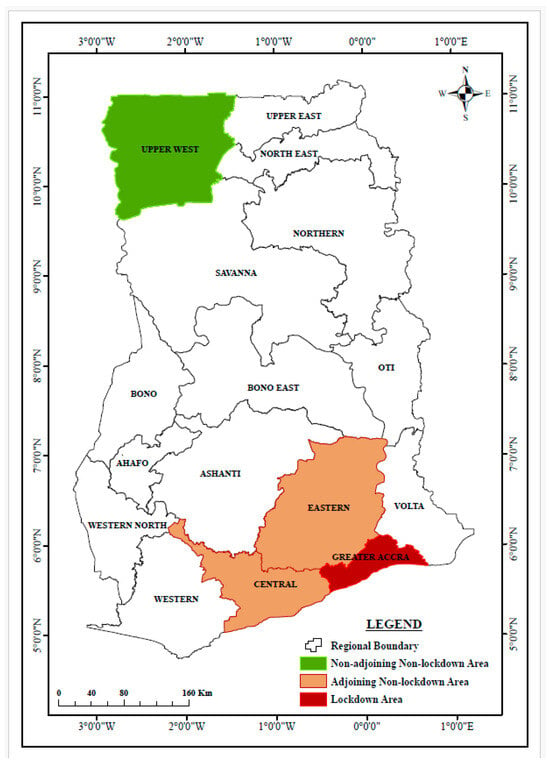
Figure 1.
Stratification of Study Areas in Ghana, according to Lockdown Conditions (Source: Authors).
The Greater Accra Region hosts the nation’s capital, and it is among the most urbanized parts of the country. The Central and Eastern Region is mostly made up of peri-urban contiguous areas to the Greater Accra Region. The Upper West Region is the northern Ghana USAID Zone of influence. The Upper West Region is largely rural, and the levels of poverty and food insecurity are relatively high.
We focused on the production, intermediary, and consumption ends of Ghana’s food system, and interviewed farmers and consumers, assuming separability. We designed and used separate but related sets of instruments for the producers and consumers, and administered the instruments to the food system actors using a combination of face-to-face computer-assisted personal interviews (CAPI) and computer-assisted self-interviewing (CASI) approaches on the Kobo Collect platform. The choice of CAPI or CASI depended on the level of literacy of the respondents.
The sampling was based on a survey power function of the following form:
where n is the sample size, Z is the Z-distribution of the associated confidence interval, is the standard deviation of the data, and is the margin of error of the confidence interval (Cohen 1988; Serdar et al. 2021; Sullivan n.d.). Using an alpha value of 0.05, or 95% confidence interval, Cohen’s medium error of 0.0395, and a standard deviation of 0.6 yields a margin of error of approximately 0.035, a sample size of approximately 836, and power of above 80% (see Serdar et al. 2021; and Cohen 1988, for further clarification on effect size and power analysis).
We randomly selected 418 respondents, comprising 44 smallholder producers (crops and animal farmers), 148 food system intermediary service providers (traders, transporters, processors, input dealers), and 226 consumers. About 124 respondents were from the Greater Accra Region, mostly in the Greater Accra Metropolitan Area, where there was the lockdown, 80 respondents were sampled from the Central Region, mainly in the Awutu Senya East District (Kasoa), which is a peri-urban contiguous area (NLAA) to the lockdown region, 99 respondents from the Eastern Region (Kwabibirem District) (NLAA), and 115 respondents from the Upper West Region (Lawra and Wa Municipal) (which formed the NLNAA).
We conducted the survey in rural and urban households, markets, and places of business of the interviewees. The data collected included food and nutrition security, food supply and demand trends, food price changes, income or expenditure, employment, consumer behavior, producer behavior, changes in food system support services and intermediation, socio-economic and livelihood changes, and geospatial information. We collected two-period data—pre-pandemic (2019) and nearly post-pandemic periods (April 2021)—to account for the possible effects of COVID-19 on Ghana’s food system. We transformed the data into pooled cross-sectional data, giving a total sampleobservation of 836 over the two years.
2.3. Panel Analytical Framework for Livelihood and Spatial-Economic Change and Endogeneity
Even though the livelihood outcomes of food system actors are not entirely dependent on agriculture, agriculture is the major driver of the livelihood outcomes of farming system actors (Barrett 2020; Béné 2020). However, a defining characteristic of agriculture is its exposure to disease, weather, climate, and natural calamities, which usually generate large swings in food supply and livelihood changes (Hovhannisyan et al. 2020). When combined with the spatial variations in economic and biophysical characteristics, food demand and supply instability can generate considerable cyclical variability in the livelihood outcomes of food system actors. There is evidence to show that changes in the factors affecting agricultural production are also important drivers of the livelihood outcomes of farming system actors, especially in sub-Saharan Africa (Abegunde et al. 2019; Bjornlunda et al. 2020; Giller et al. 2021; Loison 2015; Tsikata 2016). Despite this reality, the literature on COVID-19 and its related policy effects has overlooked this source of livelihood variation because of limited data, thus, relying only on economic drivers for the identification of structural changes in livelihood parameters caused by COVID-19 (Asegie et al. 2021; Hossain 2021; Jain et al. 2022; Laborde et al. 2021; Rasul et al. 2021; Nolte et al. 2022).
There may be endogeneity, given that the error terms in the estimation equations reflect both unobserved demand and supply effects and can generate inconsistent parameter estimates and economic effects, ultimately leading to erroneous policy recommendations (Hovhannisyan and Bozic 2017). For instance, drought-induced food price spikes may create an impression of structural livelihood changes among food system actors when no such changes have occurred. To address such endogeneity, we used a reduced-form pooled-panel equation model (Ash et al. 2020; Dang and Trinh 2022; Hovhannisyan et al. 2020; Ma et al. 2022). The reduced-form panel model expresses the effects of anticontagion COVID-19 policies on aggregate food system actor’s livelihood outcomes, y, in the data (here, y refers to food security, food expenditure, food expenditure share, and income), making it possible to disentangle the simultaneous effects of the demand and supply forces on the livelihood outcomes. This approach identifies plausible causal effects on food system outcome changes induced by exogenous shocks in independent policy variables, z (e.g., movement restrictions, school closure, and travel restrictions due to COVID-19), controlling for other drivers and socio-demographic drivers, denoted as x and w, respectively. Let f(.) describe a complex and unobserved process that generates outcome, y. Then, y is a function of X, Z, and W, defined implicitly as follows:
where y_it represents the livelihood outcome variables, , …, are socio-demographics drivers, , … are exogenous shocks caused by COVID-19 and its anticontagion policies, and , …, are other omitted drivers. Thus, the reduced-form econometric model captures elements of f(.) explicitly and then simulates how changes in z, x, or w affect y. One can differentiate Equation (1) with respect to the jth policy, , as follows:
which describes how changes in the policy affect the food system outcomes through pathways mediated by , …, . The reduced-form econometric approach thus, attempts to measure ∂y/ directly, exploiting the exogenous variation in policies, z.
2.4. Empirical Strategy and Machine Learning Estimation
Explicitly, we specified the reduced-form panel model as follows:
where is a constant, and represents dummy variables for COVID-19 anticontagion policy areas, for the ith respondent, represents food supply and demand drivers, represents the respondents’ socio-demographic characteristics, is an idiosyncratic error term, and is the random error term. We expect the effects of the COVID-19 pandemic to result from the joint influence of the anticontagion policies and stimulus supports. The policy categories were coded as binary variables, following the dummy variable approach of the treatment variable by Dang and Trinh (2022), where “[policy variable, z]” = 0 if the policy was not implemented in the spatial unit, and “[policy_variable, z]” = 1 if the policy was implemented in the spatial unit. The main policy categories identified across the study regions fall into two broad classes: time- and location-based policies. The time dummy is used to capture the overall pandemic period or COVID-19 effects on the food system, whereas the location dummies measure the location-specific anticontagion policy effects on the livelihoods of the food system actors in the location. The time dummy may capture nationwide COVID-19 effects through policies, such as social distancing, work from home, airport, and border closures, travel restrictions, food price shocks caused by supply and demand changes, school closures, and nationwide utility subsidies. The location-based dummies measure additional location-specific effects of COVID-19 lockdowns on the livelihoods of food system actors. We combined R and ArcGIS for the analysis. We also tested for correlation, multicollinearity, and endogeneity and used robust standard deviations to correct any possible standard error biases caused by endogeneity.
In analyzing the effects of COVID-19 and COVID-19 anticontagion policies on the livelihoods of food system actors, we used 80 percent of the data as the training dataset and the remaining 20 percent of the data as the test data. We performed variable selections for each of the analytical models (see the Appendix A for sample variable selection). The maximum number of variables to be selected was 11. Using forward stepwise variable selection, we obtained the best combination of variables that gave the minimum margin of error in predicting the dependent variables. The machine learning variable selection approach simply involved running several regressions, using 1, 2, 3…11 variables in the model. Each of the regressions was cross-validated using K = 10 (10 folds) cross-validation and sampling with replacement, which simply means that each variable set model ran at least 10 times. Thus, the data were randomly split into 10 folds, and, for each run, the regression model used 9 out of the 10 data splits, and then predicted the outcome based on the regression model from the 9 data folds using the 10th data fold. The errors for each of the models over the 10 runs were averaged and compared to obtain the optimal model with the best number of variable combinations and the minimum predictive error. In terms of model selection for the model estimation, we used nine machine leaning estimation techniques, such as subset, ridge, lasso, generalized additive (GAM), K-nearest neighbors (KNN), linear discriminant analysis (LDA), quadratic discriminant analysis (QDA), logistic regression, and generalized linear (glm) models, in the pooled cross-sectional model setting. For the dichotomous dependent variable, such as in the food security model, we used machine learning classifiers, such as the logistic regression, KNN, LDA, and QDA models, while the subset, ridge, lasso, GAM, and glm models were used as continuous dependent variable models. Like the variable selection, we performed model selection to identify the best model with the minimum test error, maximum adjusted R-square, or minimum Bayesian information criterion (BIC). Having identified the optimal combination of variables to use for the regression analysis, we ran each of the machine learning models and performed leave-one-out cross-validation to test the robustness of the machine learning results. The model with the minimum test error and maximum adjusted R-square or minimum BIC was chosen. This ensured that the selected model in each case did not overfit the data. However, we do not report all model results in this paper. The results presented in this paper are the best machine learning models with the least test error.
3. Results
3.1. Socio-Demographic Characteristics of Respondents
We begin with the comparative statistics of the socio-economic characteristics of the respondents in 2019 (before COVID-19) and 2020 (during COVID-19). The age, gender, household size, number of children within households, and marital status are the essential demographic factors considered in this study. From the estimates in Table 1, the average age of the sampled respondent is 40.4 years. Ghana’s population age structure is transitioning from a children-dominated to a working-age-dominated population (18+ years), with working-age groups forming about 58.2 percent of the entire population of Ghana (GSS 2021a). The study respondents fall within the predominant working-age group in Ghana. Most of the interviewed respondents for this study are female (60.53 percent). Ordinarily, more females work in the food system than males, and females form the largest percentage of Ghana’s population (GSS 2021b). The average household size of the respondents is about 5.49, and each household has an average of about 2 children. The national average household size is about 3.6, but the average household size of the populations in our study locations ranges from 3.2 in the Eastern and Greater Accra Regions to about 4.6 in the Upper West Regions (GSS 2021c). Thus, the study sample falls outside of the range of household sizes in the study areas, partly because our sample focuses on food system actors only, who usually have higher household size than the national average. On average, the respondents have about 9 years of formal education, which translates to the completion of junior high school in Ghana, and majority of the respondents are married (52 percent).

Table 1.
Demographic Descriptors of Respondents.
3.2. Effects of COVID-19 Anticontagion Policies on Livelihoods
The major changes in the livelihood patterns and the behavioral outcomes among the food system actors are noteworthy phenomena of the effects of the COVID-19 anticontagion policies in Ghana. Some of the major structural changes of COVID-19 on the livelihoods of the farming system actors include income, employment, food demand, and food security changes (Table 2). In the pandemic era, the average monthly income of the food system actors significantly decreased by about 11.6 percent, from GHS 1330.00 in 2019 to GHS 1176.00 in 2020. However, the levels of employment significantly increased by about 1.3 percent (p < 0.001), from about 92.3 percent in 2019 to about 93.6 percent in 2021. Even though the overall levels of employment increased in the pandemic year, there were structural shifts in employment from full-time to part-time. From Table 2, among the interviewed food system actors, full-time employment decreased by 14.6 percent, from 84.9 percent in 2019 to 72.5 percent in 2020, whereas part-time employment increased by about 82.1 percent, from 15.1 percent in 2019 to 27.5 percent in 2020. Due to the increases in part-time jobs, we found that the average number of months that the unemployed respondents were out of employment decreased from 10.6 months in 2019 to 9.1 months in 2020, a decrease of about 14.8 percent in unemployment months.

Table 2.
Changes in Livelihood Outcomes of Food System Actors.
There were also changes in the respondents’ food demand behavior. On average, the respondents expended an additional 14 percent of their income on food purchases. This increase in food expenditure constituted an increase of about 42.7 percent in the share of the respondents’ income expended on food purchases before the pandemic. This finding has support from the World Bank, in that food inflation is about 40.1 percent in Ghana (World Bank 2023). The adult food security estimates decreased by 13.8 percent, from 80 percent before the pandemic to 69 percent during and after the pandemic. Bukari and colleagues found that 69 percent of the households in Ghana were food-secure due to the pandemic (Bukari et al. 2022). Asravo and Kwakwa also acknowledged that COVID-19 reduced the urban household food security by about 66 percent (Asravor and Kwakwa 2022). Interestingly, the change in food security due to COVID-19 in our study is low. There are two possible reasons for this. First, the earlier studies did not focus on the food system actors. For instance, Apaliya and colleagues found that the Ghanaian food system experienced disturbances that resulted in a reduced output, due to limited labor mobility; nevertheless, these disruptions were minor and did not appear to have a significant impact on production (Apaliya et al. 2022). Second, roadblocks and limited transportation may imply that the food system actors may have had to consume the surplus food items from their production, which would have otherwise been sold.
Child food insecurity, likewise, decreased by about 10.3 percent, from the pre-pandemic level of 87 percent to a pandemic level of about 78 percent. Adult food rationing may have contributed to the relatively lower decreases in child food security and higher increases in adult food insecurity (Apaliya et al. 2022; Asravor and Kwakwa 2022).
One of the most stable variables of the respondents over the study period was their years of formal education. When the livelihood outcomes of a respondent in the pre-pandemic and pandemic years are measured and parametrized against a static parameter—such as the years of education—of the same households, the full extent of the shifts in the livelihood outcomes for individual food system actors become even more apparent and starker. In Figure 2, Figure 3 and Figure 4, we compare the same respondent’s average monthly income, average monthly food expenditure, and the average food budget share in 2019 and 2020 over the structurally static fixed years of formal education.
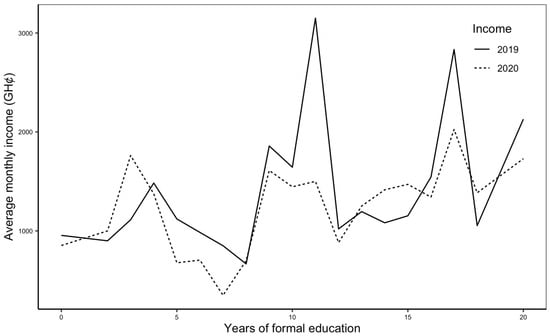
Figure 2.
Income Shift due to COVID-19 Outbreak.
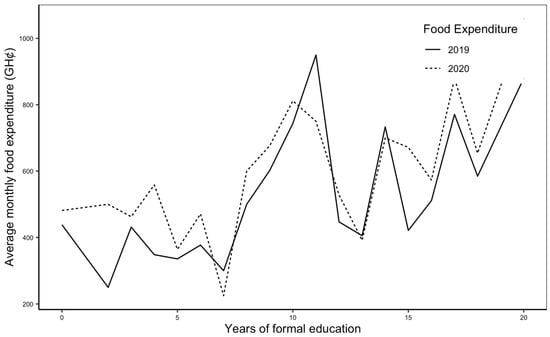
Figure 3.
Food Expenditure Shift due to COVID-19 Outbreak.
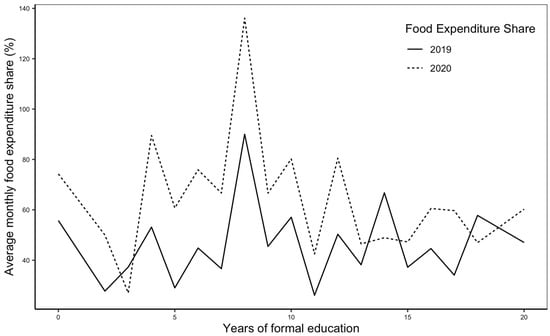
Figure 4.
Food Expenditure Share Shift due to COVID-19 Outbreak.
From Figure 2, holding other factors constant, we can observe a general downward shift in the income of the respondents in the pandemic year, relative to the pre-pandemic period. Even though we do not observe a uniform pattern of income shifts, the incomes of the respondents with lower levels of education plummeted the most. Thus, the incomes of the relatively highly educated actors, though shifted downward, were not as highly affected as the low-educated food system actors.
The food expenditure patterns among the food system actors also changed, with an upward shift in the food demand curves for 2020, relative to 2019, holding other factors constant (Figure 3). The change in the amount expended on food becomes more apparent when expressed in percentage terms (Figure 4). The pattern of the respondents’ food expenditure share shifted upward for all of the food system actors. However, the highest upward food expenditure share occurred among the respondents with relatively lower levels of education. This suggests that, as the income of the low-educated respondents decreased, their food expenditure increased, thus, leading to a larger budget share of their income.
Our regression analysis also shows that within the lockdown and non- lockdown areas, the COVID-19 outbreak disproportionately affected the average monthly incomes of the food system actors (Table 3). The farming system actors in the locked-down areas and the adjoining communities gained more income, relative to the farming system actors in the distant non-locked-down areas. The respondents with more working household members were able to gain more income during the pandemic, probably, due to increased part-time employment opportunities. However, the households with more children had their income reduced, probably due to the inability to work because of child caregiving. The farming system actors who were male, married, or had higher education also gained more income during the pandemic.

Table 3.
Effect of COVID-19 on Incomes of Food System Actors.
Another major phenomenon observed during the peak COVID-19 pandemic period was rising food demand. From Table 4, we can see that there is a positive significant relationship between COVID-19 and consumer food demand. Thus, the food consumers had to raise their budget share to meet their food requirement. Likewise, in the locked-down and adjoining areas, the food system actors increased their food expenditure shares, relative to the distant non-locked-down non-adjoining areas. The farmers and consumers expended more on food, relative to the intermediaries. The relatively old farming system actors also expended more on food. An increasing household size also increased the demand for food. The educated, male, married, and respondents with more children also expended more on food.

Table 4.
Effect of COVID-19 on Food Demand.
An increasing food demand and high prices in most instances led to high food insecurity, especially among the existing vulnerable households (Huss et al. 2021). From Table 5, we can see that COVID-19 significantly reduced the level of food security among the food system actors. Also, the level of food security reduced in the locked-down areas but increased in the adjoining areas of the locked-down communities. The level of food security among the farmers increased, whereas the food security of the consumers reduced. As age and household size increased, food security increased. The level of food security among the educated, male, and married respondents also increased. Thus, the COVID-19 pandemic has created major shifts in the livelihoods of the farming system actors. While the scourge of the pandemic is still not over, the results from the analysis of the field data in this study show that COVID-19 has shifted the incomes, employment, food demand, and food security of the food system actors.

Table 5.
Effect of COVID-19 on Food Security.
The incomes of the food system actors trended downwards during the COVID-19 period, whereas a significant number of employment types shifted from full-time to part-time. This shift in employment from full-time to part-time provided an avenue for unemployed people to enter the labor market. As the respondents’ incomes were plummeting, they were also expending a high proportion of their income to acquire food, probably due to price increases during the lockdowns. The full effect of the rising food expenditure resonates in the increased child and adult food insecurity. The lockdown areas and their adjoining communities were the most affected areas.
3.3. Effect of Pandemic Spatial Policy Variations on Livelihood Outcomes
We have already shown the effects of the pandemic on shifts in the structural pattern of the livelihoods of the farming system actors. From Figure 5, Figure 6 and Figure 7, we can see a general pattern of decreases in the average income over the pandemic period and increases in the food expenditure and the food budget share. However, these effects vary based on the spatial policies adopted to curb the spread of the disease. Figure 8, Figure 9 and Figure 10 confirm these spatial variations. As shown in Figure 8, the income levels of the farming system actors in the lockdown areas, and those of the non-contiguous communities to the lockdown areas decreased, whereas the incomes of the farming system actors in the communities directly adjacent to the lockdown areas increased.
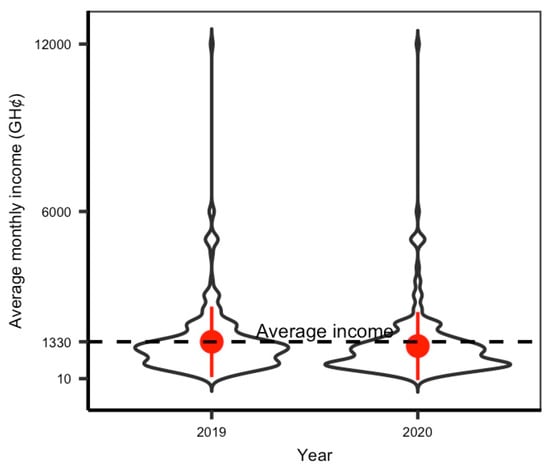
Figure 5.
Income changes.
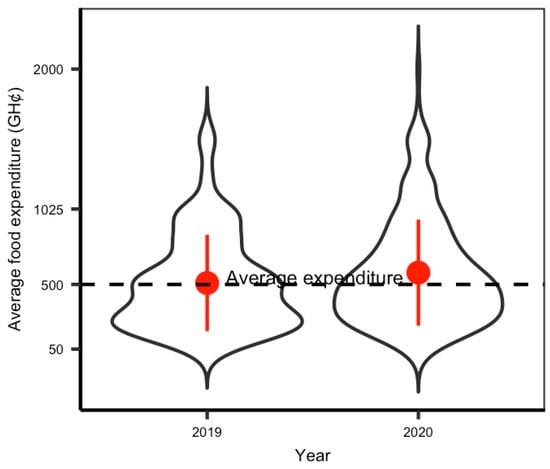
Figure 6.
Food Expenditure Changes.
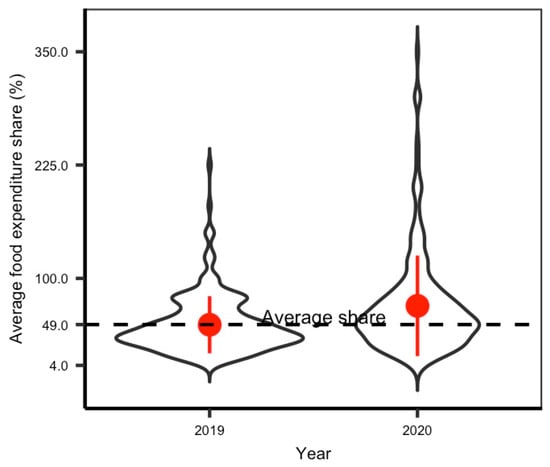
Figure 7.
Food Expenditure Share Changes.
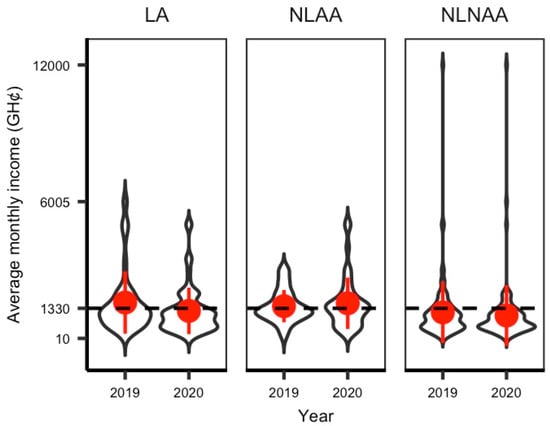
Figure 8.
Income Changes Across Policy Areas.
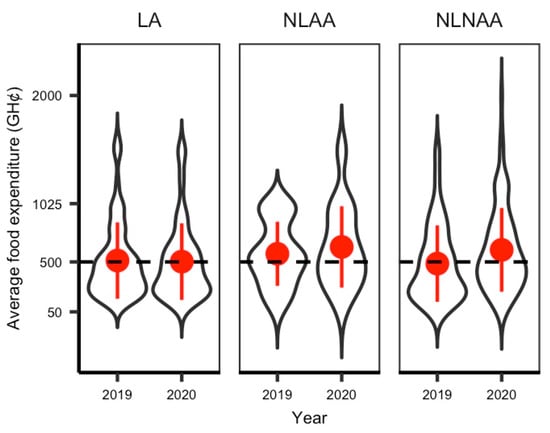
Figure 9.
Food Expenditure Changes Across Policy Areas.
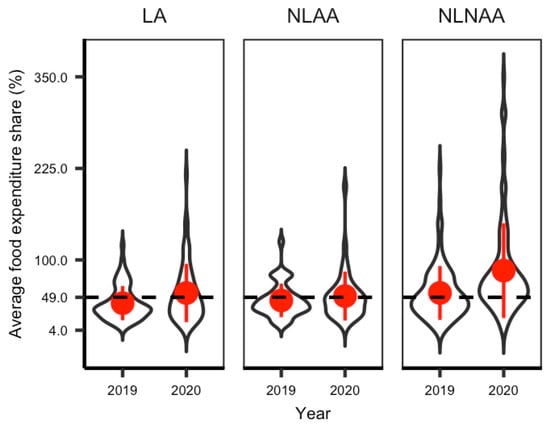
Figure 10.
Food Expenditure Share Changes Across Policy Areas.
Even though there were no restrictions on food transportation and distribution, in order to enable social distancing, the trading activities were organized based on daily shifts. This disrupted the market supply chains in terms of a reduced demand for bulk food distributions, due to storage and warehouse challenges. There were also transportation challenges, as many of the transporters believed that the increased roadblocks with some military at the post may hinder their distribution capacities. The farming system actors in the lockdown areas, mostly food traders, had a reduced food supply compared with that of the rural areas. These actors also had to take turns to sell their food in the market because of COVID-19, hence, their incomes plummeted. Similarly, the farming system actors in the non-contiguous communities, mostly producers, could not supply the urban market due to the perceived fear of security harassment at the roadblocks in the locked-down areas. This contributed to their reduced income levels. On the contrary, the food supply to the locked-down areas was mostly from the farming system actors in the directly adjoining communities to the locked-down areas. With reduced food supplies from the distant non-contiguous areas, there was an increased demand and an increased food supply opportunity for the farming system actors in the nearby peri-urban contiguous communities to the locked-down areas.
Likewise, as shown in Figure 9 and Figure 10, even though there were general increases in food expenditure and food expenditure share across all of the spatial units of the farming system actors, we see relatively high food expenditure among the actors in both the direct locked-down contiguous areas and the non-contiguous areas. The increased food expenditure in these two spatial units might have resulted from a reduced supply of processed food items from the urban locked-down areas to the adjoining suburban and rural areas, due to disrupted transportation from the increased security posts and roadblocks. The increased food expenditure, especially in the non-contiguous areas, combined with the reduced income, reflects in the highest food budget share of the farming system actors in the non-contiguous locked-down areas.
On the contrary, despite the increase in the food expenditure of the farming system actors in the direct contiguous communities to the locked-down areas, the actors in these locations had a relatively lower expenditure share. Thus, overall, the main losers were the farming system actors in the locked-down areas and in the distant contiguous areas. The farming system actors in the contiguous communities, even though they expended more on food during the pandemic, benefitted from an increased income from shoring up the reduced food supply from the actors in the distant non-contiguous areas. As a result, the share of their income expended on food during the pandemic was nearly the same as that of the pre-pandemic levels. Again, Figure 8, Figure 9 and Figure 10 show a stable income and food expenditure share among the farming system actors in the direct contiguous communities in the lockdown areas, but stark changes in the livelihoods pattern of the farming system actors in the locked-down and non-contiguous communities.
4. Discussion and Policy Considerations
While the worst of the COVID-19 pandemic appears to be over, the world is still reeling from its impacts. We analyzed the cascading effects of the COVID-19 anticontagion policies on the livelihoods of food system actors across different policy-induced spatial units. This analysis uses cross-sectional pooled-panel data from farming system actors in Ghana. Given the multilevel nature of the data in a developing country setting, we use machine learning techniques, such as the general additive model (GAM), subset regression, and generalized linear models. We consider a broad array of COVID-19-induced food system issues in Ghana, which also had serious policy implications for the rest of the sub-Saharan African region, and utilize robust machine learning modeling approaches in this study to link food systems and COVID-19 policies.
We found that in the pandemic era, the average monthly income of the food system actors significantly decreased by about 11.6 percent. The decrease in income resulted from the closure of food and food-related businesses during the pandemic. We also tested the livelihood changes across three spatial units—the locked-down areas, the neighboring communities to the locked-down areas, and the communities that were extremely distant from the locked-down areas. We found that the COVID-19 mitigation policies led to cascading spatial economic variations among the food system actors across the spatial units. The income levels of the farming system actors in the lockdown areas, and those in the non-contiguous communities to the lockdown areas decreased, whereas the incomes of the farming system actors in communities directly adjacent to the lockdown areas increased. Overall, we found that the main losers were the farming system actors in the locked-down areas and those living in the distant communities that were non-contiguous to the locked-down areas. The main beneficiaries of the lockdown policies were the food system actors in the neighboring communities of the locked-down areas.
Our explanation for these differential incomes is that this income shifts stems from the travel restrictions, roadblocks, increased military, and other security agency presence, the fear of military brutality, and the closure of businesses. Due to the increased roadblocks and the fear of brutality due to the increased military presence in the locked-down areas, many of the food system actors, such as food transport truck operators, in the locked-down areas failed to operate. Also, because most of the locked-down communities tended to be mostly urban, most of the food system actors in these areas were traders, agro-processers, restaurant and small food joint operators, and agro-input dealers. With markets, restaurants, and businesses closed, and many of their clients at home due to lockdown, the demand for the services of the urban food system actors became diminished, leading to a reduced income. In a similar manner, even though the food system actors operating in the communities in distant areas that were not under lockdown also lost incomes, it was not as much as that of the actors in the locked-down areas. Most of these distant communities tended to be rural and, as such, relied on derived urban food demand to gain income. In fear of harassment at roadblocks in the locked-down areas, the actors in this spatial unit could not supply their farm produce or their services to the urban locked-down areas for income. On the contrary, the farming system actors in the contiguous peri-urban or suburban areas to the locked-down areas took advantage of the artificial food supply shortages induced by limited food supply from the rural distant areas. Those farming system actors gained more income by supplying food and food system services to clients both in their community and in the locked-down areas. The increased demand for their goods and services, due to the supply gaps from the rural distant communities, also led to price hikes in the food commodities and services, which contributed to an increased income for the food system actors in the communities bordering the locked-down areas.
The levels of food security across the three spatial units of the COVID-19 policies also followed similar patterns as that of the income distribution. The level of food security was reduced in both the lockdown areas and the distant rural communities, but less so in the adjoining rural communities. In the adjoining communities, the levels of food security increased. The food supply shortages, the disruption of traditional markets (which involved in some cases a complete lockdown of markets for fumigation), or rationing in market use explain the rise in food insecurity in the locked-down areas. In the distant non-contiguous communities, the decrease in food security may be the result of shortages in industrial food products and associated price hikes.
Even though there were general increases in food expenditure and food expenditure share across all the spatial units of the farming system actors, we see relatively high food expenditure among the actors in both the direct locked-down contiguous areas and the non-contiguous areas. The increased food expenditure in these two spatial units might have resulted from a reduced supply of processed food items from the urban locked-down areas to the adjoining suburban and rural areas, due to disrupted transportation from increased security posts and roadblocks. The increased food expenditure, especially in the non-contiguous areas, combined with the reduced income, reflects in the highest food budget share of the farming system actors in the non-contiguous locked-down areas. In the locked-down and adjoining areas, the food system actors increased their food expenditure shares, relative to the distant non-locked-down non-adjoining areas. The increasing food demand and high prices in most instances led to high food insecurity, especially among the existing vulnerable households (Huss et al. 2021; Apaliya et al. 2022; Asravor and Kwakwa 2022).
We also found major changes in the behavioral patterns and a deterioration in the livelihood outcomes across the general food system structures. On average, the respondents expended an additional 14 percent of their income on food purchases. This increase in food expenditure constituted an increase of about 42.7 percent in the share of the respondent’s income expended on food purchases, relative to the pre-pandemic period. The adult food security estimates decreased by 13.8 percent, from 80 percent in the year before the pandemic to 69 percent during and after the pandemic. The child food insecurity, likewise, decreased by about 10.3 percent, from the pre-pandemic level of 87 percent to a pandemic level of about 78 percent. Adult food rationing may have contributed to the relatively lower decreases in child food security and the higher increases in adult food insecurity. Full-time employment decreased by 14.6 percent, from 84.9 percent in 2019 to 72.5 percent in 2020, whereas part-time employment increased by about 82.1 percent, from 15.1 percent in 2019 to 27.5 percent in 2020. Due to the increases in part-time jobs, we found that the average number of months that the unemployed respondents were out of employment decreased from 10.6 months in 2019 to 9.1 months in 2020, a decrease of about 14.8 percent in unemployment months.
Even though our findings have many important policy implications for the design and implementation of food system policies and programs for low- and middle-income countries, we settle on two key policy issues. First, effective post-pandemic food system policymaking and programs demand matching policy incentives for food systems support and services with the cascading and trickling down effects of the COVID-19 anticontagion policies. From the perspective of the cost-effective design of food policies and programs, understanding the spatial dimensions of the COVID-19 policies that influence the food system actor’s livelihood outcomes and behavioral patterns can inform policymakers about heterogeneity in the effect of the pandemic policies on food system actors. Such knowledge contributes to the creation of tailored policies towards food system actors’ heterogeneous preferences and the spatial targeting of policy interventions. In this study, we have found that the lockdown policies adopted during COVID-19 have created heterogenous food system effects on livelihood outcomes that blanket policies may not address.
We also note that the Ghanaian government has expended over USD 100 million on COVID-19 recovery programs, and, globally, over USD 12 trillion has already been spent on COVID-19 economic recovery programs (Markandya et al. 2021; Ministry of Finance 2022; World Bank 2023). While we do not know the specific impacts of the COVID-19 recovery programs on the Ghanaian food system, the global estimates from the United Nations show that more than 4 billion individuals of the world’s vulnerable population groups, including the young and the elderly, remain uncovered by the statutory social protection programs (UN 2023). Also, the COVID-19 economic recovery programs have not sufficiently addressed food security and sustainability (Markandya et al. 2021). The United Nations warns that the economic recovery from the COVID-19 pandemic has been slow and uneven, with 41 percent of low-income countries experiencing a higher poverty rate in 2021 compared to the previous year, versus only 13 per cent of the upper-middle-income countries (UN 2023). The United Nations stress that the Sustainable Development Goals are in grave jeopardy; moreover, under the current recovery trends, 575 million people will still be living in extreme poverty in 2030, and only about one third of countries will meet the target to halve the national poverty levels. The world is back at hunger levels that have not been seen since 2005, food prices remain higher in more countries than in the period of 2015–2019, and the lingering effects of COVID-19 continue to derail the progress in food security. Our findings do not only give insight into the most vulnerable population, but also the locations of the most vulnerable groups for effective policy planning and targeting. New policies and programs are necessary to address the livelihood challenges and inequalities and injustices across the food systems that have emerged and prevail post-COVID-19 (Barrett 2020; Gruère and Brooks 2021; Laborde et al. 2020; Markandya et al. 2021)
Second, even though the COVID-19 anticontagion policies have been largely successful for mitigating the pandemic, there are lingering concerns regarding the effects of the policies on food system actors, which can be used to guide future pandemic policies. We address this concern in our paper. The effects of COVID-19 on food system actors vary, not only based on their resilience, but also on the nature of the spatial policies adopted to curb the spread of the disease. Our paper lends support to effective anticontagion policies that assure the free movement of goods and services, devoid of military interventions and roadblocks, and combine continuous effective communication.
5. Conclusions and Recommendations
Even though sustained episodes of growth are underpinned by fundamental structural changes, the full effects of COVID-19 are devasting and may have extenuating effects over a long period of time. Understanding these effects and the role of the lockdowns is important for shaping future pandemic management. From this analysis, we can see that COVID-19 shifted the structure of local economies, and food systems are among those affected. The food system actors in the locked-down areas and the distant areas from the locked-down communities are the most affected groups. This suggests that the lockdown policies may have contributed to the observed low income, employment shifts, and food insecurities among the farming system actors in these areas. The government of Ghana, through funding support from the World Bank, established the COVID-19 alleviation and revitalization of enterprises support (Ghana CARES Obaatanpa) program to mitigate the impact of COVID-19 on livelihoods and to ensure that Ghanaians can quickly emerge from the pandemic (Ministry of Finance 2022). The government may still need to do more to balance out the disproportionate effects of the anticontagion polices across the different spatial units. For instance, food inflation—which was brought stark by COVID-19, during which local food prices increased in some parts of the country—has remained, and even elevated to about 40.1% in August of 2023. The government, therefore, needs to provide additionaleconomic support and assitance to the food system actors across the policy areas. Government support to food system actors will have micro-level benefits of enhancing the livelihoods of the food system actors, and macro-level implications of reducing food inflation.
Our study is subject to several limitations. First, our empirical analysis is only limited to one country. Even though the results from this analysis can be indicative of the outcomes in similar countries, it is not entirely representative of the entirety of sub-Saharan Africa. Second, the period of study is short, and thus, the outcome may not fully capture the dynamic changes in the livelihoods of food system actors. Considering that COVID-19 effects still linger on Ghana’s economy and the food system, as evidenced through high food inflation and the full-blown macro-economic crisis in 2022, studies to track the trajectory of the COVID-19 impact over a long period will be useful (World Bank 2023; OBG 2023). We are unable to identify a meaningful instrument for COVID-19. While we tested for correlation, multicollinearity, and endogeneity and used robust standard deviations in our models, future studies that can identify the instruments for COVID-19 may give new insights. However, it is important to consider that socioeconomic events, including COVID-19 policy effects, are complex, far-reaching, and multidimensional. Therefore, it is harder to come up with complete, well-defined models in such a non-experimental natural environment, making it more difficult to predict than in the physical process or framed field experimental settings. It is important to consider other metrics of model quality, such as its predictive capacity in test data and error margins in a machine learning environment, in order to gain a more comprehensive understanding of the performance of the models (Giwa-Daramola and James 2023). Our results have extremely low test errors of approximately 11 percent, which means that the model accurately predicts outcomes around 90 percent of the time. Notwithstanding the limitations of this study, we have drawn important conclusions about the micro-level effects of the pandemic policies on the livelihoods of the food system actors in a sub-Saharan African context. Like Ghana, most of these countries are still facing the lingering effects of COVID-19 across their food systems, which governments and other policymakers must urgently address.
Author Contributions
Conceptualization, S.F. and B.A.; Methodology, S.F.; Data Collection: H.F. and S.F.; Software, S.F. and H.F.; Writing—original draft, S.F.; Writing—review & editing, I.D.B. and A.B.O.; Supervision, S.F. and B.A. All authors have read and agreed to the published version of the manuscript.
Funding
This research received funding support from the internally generated fund of the Food and Agriculture Organization.
Institutional Review Board Statement
Not applicable.
Informed Consent Statement
Not applicable.
Data Availability Statement
The data presented in this study are available from the FAO Ghana and will be shared upon request.
Acknowledgments
The authors acknowledge the administrative support of FAO Ghana support staff, especially Arnold Amppiah.
Conflicts of Interest
The authors declare no conflict of interest.
Appendix A. Sample Stepwise Variable Selection for the Income Model (Table 3)
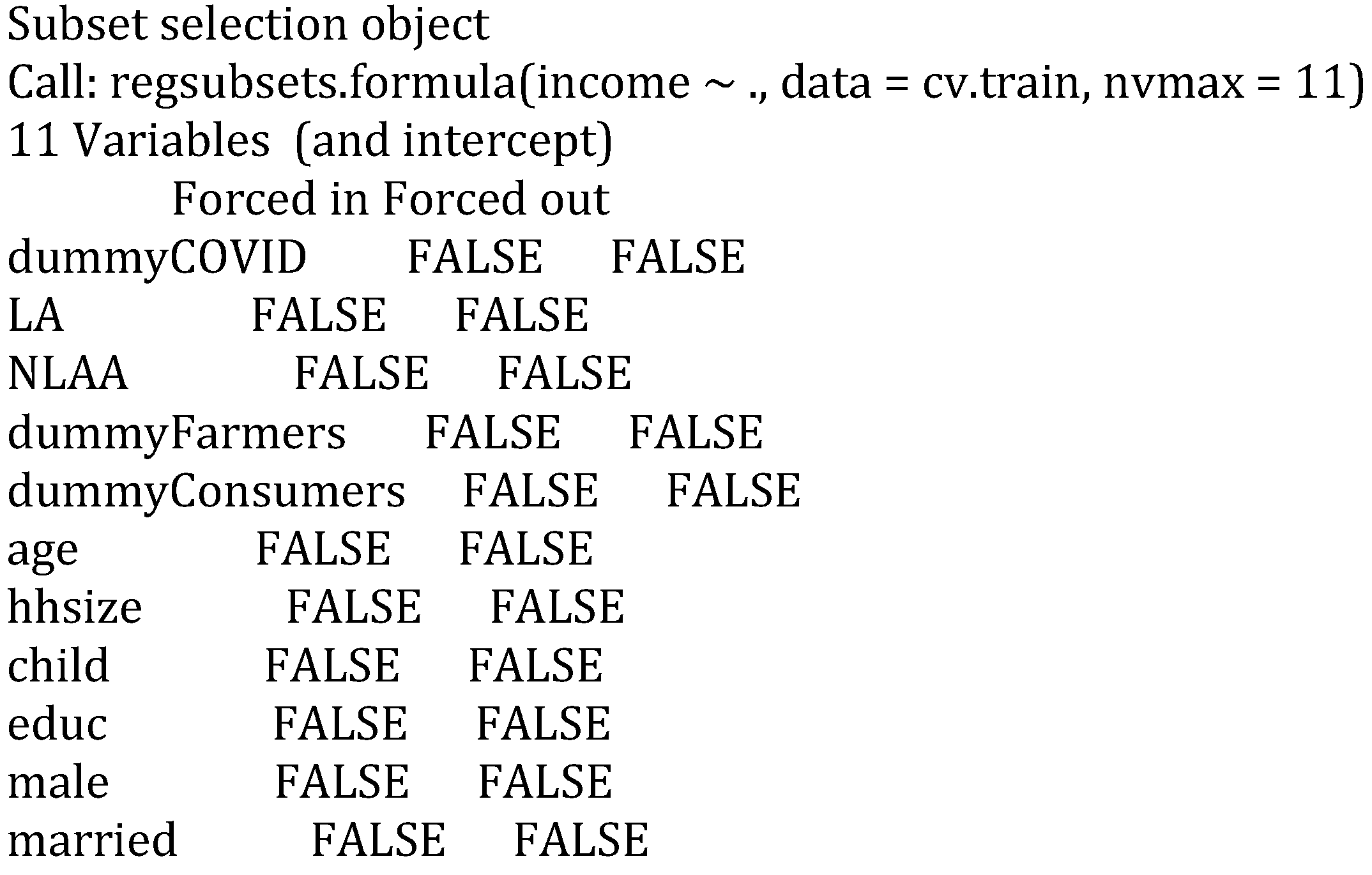
| 1 subset of each size up to 11 | ||||||||||
| Selection | Algorithm: | exhaustive | ||||||||
| dummyCOVID | LA | NLAA | dummyFarmers | dummyConsumers | age | hhsize | child | educ | ||
| 1 | (1) | “ ” | “ ” | “ ” | “ ” | “ ” | “ ” | “ ” | “ ” | “*” |
| 2 | (1) | “ ” | “*” | “ ” | “ ” | “ ” | “ ” | “ ” | “ ” | “*” |
| 3 | (1) | “ ” | “*” | “*” | “ ” | “ ” | “ ” | “ ” | “ ” | “*” |
| 4 | (1) | “ ” | “*” | “*” | “ ” | “ ” | “ ” | “ ” | “ ” | “*” |
| 5 | (1) | “ ” | “*” | “*” | “ ” | “ ” | “ ” | “ ” | “ ” | “*” |
| 6 | (1) | “ ” | “*” | “*” | “*” | “ ” | “ ” | “ ” | “ ” | “*” |
| 7 | (1) | “ ” | “*” | “*” | “ ” | “ ” | “ ” | “*” | “*” | “*” |
| 8 | (1) | “ ” | “*” | “*” | “*” | “ ” | “ ” | “*” | “*” | “*” |
| 9 | (1) | “*” | “*” | “*” | “*” | “ ” | “ ” | “*” | “*” | “*” |
| 10 | (1) | “*” | “*” | “*” | “*” | “*” | “ ” | “*” | “*” | “*” |
| 11 | (1) | “*” | “*” | “*” | “*” | “*” | “*” | “*” | “*” | “*” |
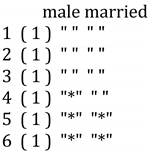 | ||||||||||
| Note: * indicates the selected variables for each subset of variable size in the analysis | ||||||||||
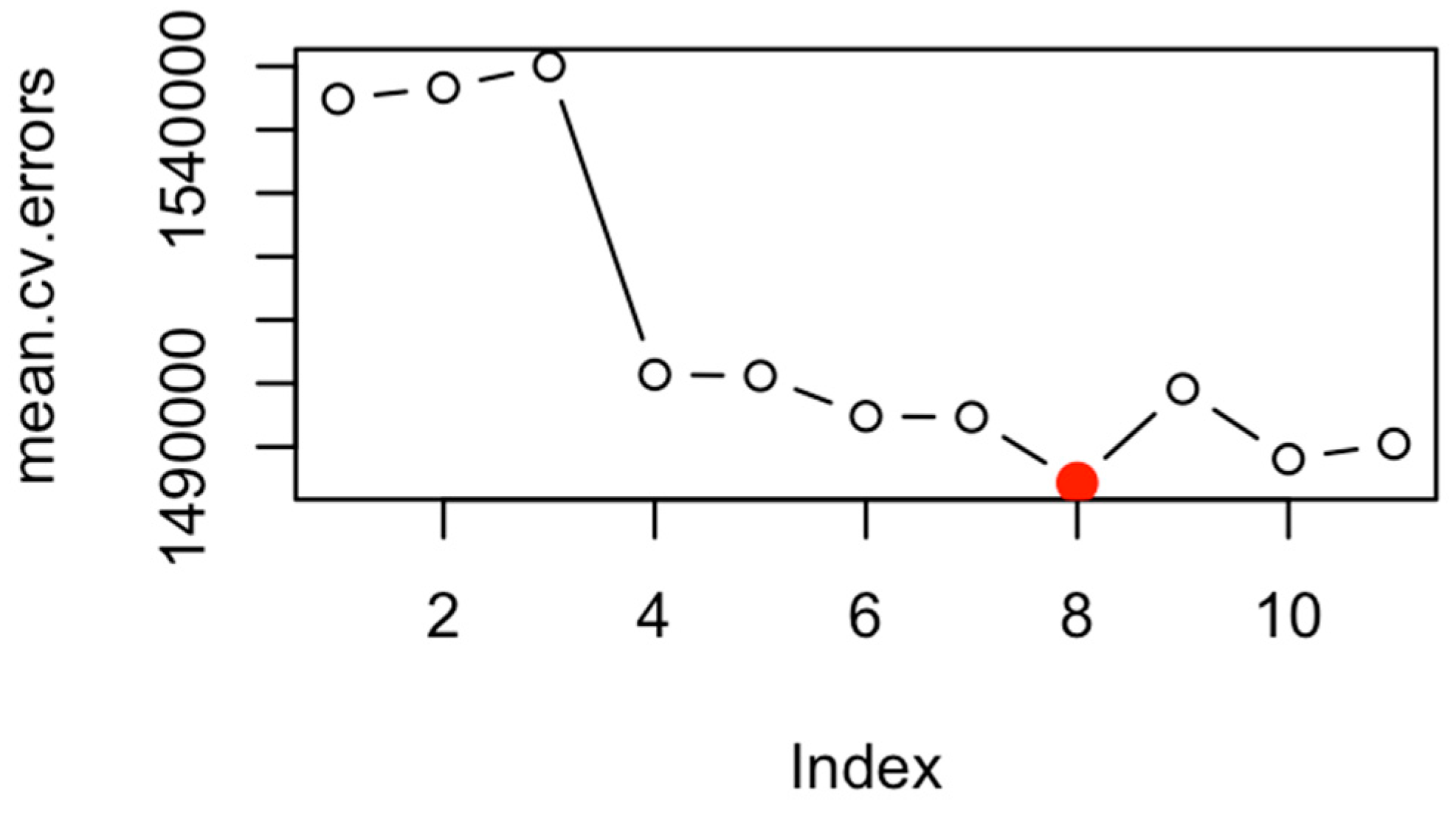
References
- Abegunde, Victor O., Melusi Sibanda, and Ajuruchukwu Obi. 2019. The Dynamics of Climate Change Adaptation in Sub-Saharan Africa: A Review of Climate-Smart Agriculture among Small-Scale Farmers. Climate 7: 132. [Google Scholar] [CrossRef]
- Aday, Serpil, and Mehmet S. Aday. 2020. Impact of COVID-19 on the food supply chain. Food Quality and Safety 4: 167–80. [Google Scholar] [CrossRef]
- AGRA (Alliance for a Green Revolution in Africa). 2014. Africa Agriculture Status Report: Climate Change and Smallholder Agriculture in Sub-Saharan Africa. Nairobi, Kenya. Available online: https://agra.org/wp-content/uploads/2021/03/agra-africa-agriculture-status-report-2014.pdf (accessed on 21 October 2023).
- Alemayehu, Tesfahun, Guy Marius Assogba, Silke Gabbert, Ken E. Giller, James Hammond, Aminou Arouna, Elliott Ronald Dossou-Yovo, and Gerrie W. J. van de Ven. 2022. Farming Systems, Food Security and Farmers’ Awareness of Ecosystem Services in Inland Valleys: A Study From Côte d’Ivoire and Ghana. Frontiers in Sustainable Food Systems 6: 892818. [Google Scholar] [CrossRef]
- Apaliya, Maurice Tibiru, Emmanuel Kwaw, Richard Osae, Rapheal Nammahime Alolga, Augustina Sackle, Sackey Aikins, Gifty Serwaa Otoo, Sandra Ama Kaburi, Francis Padi Lamptey, and Celestina Amo-Broni. 2022. The Impact of COVID-19 on Food Security: Ghana in Review. Journal of Food Technology Research, Conscientia Beam 9: 160–75. [Google Scholar] [CrossRef]
- Asegie, Asrat Mulat, Samuel Tadesse Adisalem, and Amogne Asfaw Eshetu. 2021. The effects of COVID-19 on livelihoods of rural households: South Wollo and Oromia Zones, Ethiopia. Heliyon 7: e08550. [Google Scholar] [CrossRef] [PubMed]
- Ash, Elliott, Sergio Galletta, Dominik Hangartner, Yotam Margalit, and Matteo Pinna. 2020. The Effect of Fox News on Health Behavior during COVID-19. Center for Law & Economics Working Paper Series 10/202; Zurich: Center for Open Science. [Google Scholar] [CrossRef]
- Asravor, Richard Kofi, and Paul Adjei Kwakwa. 2022. Effects of COVID-19 on urban households’ food security status in Ghana: PRE and post lockdown analysis. African Geographical Review. [Google Scholar] [CrossRef]
- Barrett, Christopher B. 2020. Actions now can curb food systems fallout from COVID-19. Nature Food 1: 319–20. [Google Scholar] [CrossRef]
- Béné, Christophe. 2020. Resilience of local food systems and links to food security—A review of some important concepts in the context of COVID-19 and other shocks. Food Security 12: 805–22. [Google Scholar] [CrossRef]
- Bjornlunda, Vibeke, Henning Bjornlunda, and Andre F. Van Rooyen. 2020. Why agricultural production in sub-Saharan Africa remains low compared to the rest of the world—A historical perspective. International Journal of Water Resources Development 36: S20–53. [Google Scholar] [CrossRef]
- Bukari, Chei, Millicent Abigail Aning-Agyei, Christian Kyeremeh, Gloria Essilfie, Kofi Fosu Amuquandoh, Anthony Akwesi Owusu, Isaac Christopher Otoo, and Kpanja Ibrahim Bukari. 2022. Effect of COVID-19 on Household Food Insecurity and Poverty: Evidence from Ghana. Social Indicators Research 159: 991–1015. [Google Scholar] [CrossRef]
- Butler, James R. A., Federico Davila, Robyn Alders, R. Michael Bourke, Steve Crimp, John McCarthy, Andrew McWilliam, Anton S. M. Palo, Lisa Robins, Michael J. Webb, and et al. 2021. A rapid assessment framework for food system shocks: Lessons learned from COVID-19 in the Indo-Pacific region. Environmental Science and Policy 117: 34–45. [Google Scholar] [PubMed]
- Cable, Jennifer, Lee-Ann Jaykus, Karin Hoelzer, John Newton, and Maximo Torero. 2020. The impact of COVID-19 on food systems, safety, and security—A symposium report. Annals of the Newyork Academic of Sciences 1484: 3–8. [Google Scholar]
- Carducci, B., E. C. Keats, M. Ruel, L. Haddad, J. S. M. Osendarp, and A. Z. Bhutta. 2021. Food systems, diets and nutrition in the wake of COVID-19. Nature Food 2: 68–70. [Google Scholar] [CrossRef]
- Cohen, Jacob. 1988. Statistical Power Analysis for the Behavioral Sciences, 2nd ed. New York: Lawrence Erlbaum Associates. ISBN 0-8058-0283-5. [Google Scholar]
- Coluccia, Benedetta, Giulio Paolo Agnusdei, Pier Paolo Miglietta, and Federica De Leo. 2021. Effects of COVID-19 on the Italian agri-food supply and value chains. Food Control 123: 107839. [Google Scholar]
- Cooper, P. J. M., J. Dimes, K. P. C. Rao, B. Shapiro, B. Shiferaw, and S. Twomlow. 2008. Coping better with current climatic variability in the rain-fed farming systems of sub-Saharan Africa: An essential first step in adapting to future climate change? Agriculture, Ecosystems & Environment 126: 24–35. [Google Scholar]
- Cooper, P. J. M., K. P. C. Rao, P. Singh, J. Dimes, P. S. Traore, K. Rao, P. Dixit, and S. J. Twomlow. 2009. Farming with current and future climate risk: Advancing a ‘Hypothesis of Hope’ for rain-fed agriculture in the semi-arid tropics. Journal of SAT Agricultural Research 7: 1–19. [Google Scholar]
- Dang, Hai-Anh H., and Trong-Anh Trinh. 2022. The Beneficial Impacts of COVID-19 Lockdowns on Air Pollution: Evidence from Vietnam. The Journal of Development Studies 58: 1917–33. [Google Scholar] [CrossRef]
- Danso-Abbeam, Gideon, Gilbert Dagunga, Dennis Sedem Ehiakpor, Abiodun A. Ogundeji, Edinam Dope Setsoafia, and Joseph A. Awuni. 2021. Crop–livestock diversification in the mixed farming systems: Implication on food security in Northern Ghana. Agriculture & Food Security 10: 35. [Google Scholar] [CrossRef]
- Dasgupta, Shouro, and Elizabeth J. Z. Robinson. 2022. Impact of COVID-19 on food insecurity using multiple waves of high frequency household surveys. Scientific Reports 12: 1865. [Google Scholar] [CrossRef]
- Fan, Shenggen, Paul Teng, Ping Chew, Geoffry Smith, and Les Copeland. 2021. Food system resilience and COVID-19—Lessons from the Asian experience. Global Food Security 28: 100501. [Google Scholar] [CrossRef]
- FAO (Food and Agriculture Organization of the United Nations). 2023. Sub-Saharan Africa. Regional Setting. Available online: https://www.fao.org/3/Y1860E/y1860e04.htm (accessed on 21 October 2023).
- FAO (Food and Agriculture Organization of the United Nations), and WFP (World Food Program). 2022. Hunger Hotspots. FAO-WFP Early Warnings on Acute Food Insecurity: February to May 2022 Outlook. Rome: FAO. [Google Scholar] [CrossRef]
- Galanakis, Charis. M. 2020. The Food Systems in the Era of the Coronavirus (COVID-19) Pandemic Crisis. Foods 9: 523. [Google Scholar] [CrossRef] [PubMed]
- Ghosh-Jerath, S., R. Kapoor, A. Dhasmana, A. Singh, S. Downs, and S. Ahmed. 2022. Effect of COVID-19 Pandemic on Food Systems and Determinants of Resilience in Indigenous Communities of Jharkhand State, India: A Serial Cross-Sectional Study. Frontiers in Sustainable Food Systems 6: 724321. [Google Scholar] [CrossRef] [PubMed]
- Giller, Ken E., Thomas Delaune, João Vasco Silva, Mark van Wijk, James Hammond, Katrien Descheemaeker, Gerrie van de Ven, Antonius G. T. Schut, Godfrey Taulya, Regis Chikowo, and et al. 2021. Small farms and development in sub-Saharan Africa: Farming for food, for income or for lack of better options? Food Security 13: 1431–54. [Google Scholar] [CrossRef]
- Giwa-Daramola, D., and Harvey S. James. 2023. COVID-19 and Microeconomic Resilience in Sub-Saharan Africa: A Study on Ethiopian and Nigerian Households. Sustainability 15: 7519. [Google Scholar] [CrossRef]
- Gruère, G., and J. Brooks. 2021. Viewpoint: Characterising early agricultural and food policy responses to the outbreak of COVID-19. Food Policy 100: 102017. [Google Scholar] [CrossRef]
- GSS (Ghana Statistical Services). 2021a. Ghana 2021 Population and Housing Census. General Report 3A. Available online: gss.gov.gh (accessed on 28 March 2022).
- GSS (Ghana Statistical Services). 2021b. Ghana 2021 Population and Housing Census. General Report 3B. Available online: gss.gov.gh (accessed on 28 March 2022).
- GSS (Ghana Statistical Services). 2021c. Ghana 2021 Population and Housing Census. General Report 3C. Available online: gss.gov.gh (accessed on 28 March 2022).
- Haider, Najmul, Abdinasir Yusuf Osman, Audrey Gadzekpo, George O. Akipede, Danny Asogun, Rashid Ansumana, Richard John Lessells, Palwasha Khan, Muzamil Mahdi Abdel Hamid, Dorothy Yeboah-Manu, and et al. 2020. Lockdown measures in response to COVID-19 in nine sub-Saharan African countries. BMJ Global Health 5: e003319. [Google Scholar] [CrossRef]
- Haug, Nina, Lukas Geyrhofer, Alessandro Londei, Elma Dervic, Amélie Desvars-Larrive, Vittorio Loreto, Beate Pinior, Stefan Thurner, and Peter Klimek. 2020. Ranking the effectiveness of worldwide COVID-19 government interventions. Nature Human Behaviour 4: 1303–12. [Google Scholar] [CrossRef]
- Hilchey, Duncan. 2021. In this issue: The impact of COVID-19 on food systems [Editorial]. Journal of Agriculture, Food Systems, and Community Development 10: 1–5. [Google Scholar] [CrossRef]
- Hossain, Mohammad I. 2021. COVID-19 Impacts on Employment and Livelihood of Marginal People in Bangladesh: Lessons Learned and Way Forward. South Asian Survey 28: 57–71. [Google Scholar] [CrossRef]
- Hovhannisyan, Vardges, and Marin Bozic. 2017. Price Endogeneity and Food Demand in Urban China. Journal of Agricultural Economics 68: 386–406. [Google Scholar] [CrossRef]
- Hovhannisyan, Vardges, Magdana Kondaridze, Christopher Bastian, and Aleksan Shanoyan. 2020. Empirical Evidence of Changing Food Demand and Consumer Preferences in Russia. Journal of Agricultural and Applied Economics 52: 480–501. [Google Scholar] [CrossRef]
- Huss, M., Michael Brander, M. Kassie, Ulrike Ehlert, and Thomas Bernauer. 2021. Improved storage mitigates vulnerability to food-supply shocks in smallholder agriculture during the COVID-19 pandemic. Global Food Security 28: 100468. [Google Scholar] [CrossRef] [PubMed]
- Jain, Shalini Sarin, Shailendra Pratap Jain, and Yexin Jessica Li. 2022. Sustaining Livelihoods or Saving Lives? Economic System Justification in the Time of COVID-19. Journal of Business Ethics 183: 71–104. [Google Scholar] [CrossRef] [PubMed]
- Kiepe, Paul. 2006. Integrating aquaculture into agroecosystems in West Africa: The roles of Warda—The Africa rice center and the inland valley consortium. In Integrated Irrigation and Aquaculture in West Africa. Rome: FAO, p. 159. [Google Scholar]
- Klassen, Susanna, and Sophia Murphy. 2020. Equity as both a means and an end: Lessons for resilient food systems from COVID-19. World Develeopment 136: 105104. [Google Scholar] [CrossRef] [PubMed]
- Kuivanen, K. S., Mirja Michalscheck, Katrien Descheemaeker, Samuel Adjei-Nsiah, S. Mellon-Bedi, Jeroen C. J. Groot, and Sophie Alvarez. 2016. A comparison of statistical and participatory clustering of smallholder farming systems—A case study in Northern Ghana. Journal of Rural Studies 45: 184–98. [Google Scholar] [CrossRef]
- Laborde, David, Will Martin, and Rob Vos. 2021. Impacts of COVID-19 on global poverty, food security, and diets: Insights from global model scenario analysis. Agricultural Economics 52: 375–90. [Google Scholar] [CrossRef] [PubMed]
- Laborde, David, Will Martin, Johan Swinnen, and Rob Vos. 2020. COVID-19 risks to global food security Economic fallout and food supply chain disruptions require attention from policy-makers. Science 369: 500–2. [Google Scholar] [CrossRef]
- Loison, Sarah Alobo. 2015. Rural Livelihood Diversification in Sub-Saharan Africa: A Literature Review. The Journal of Development Studies 51: 1125–38. [Google Scholar] [CrossRef]
- Love, David C., Edward H. Allison, Frank Asche, Ben Belton, Richard S. Cottrell, Halley E. Froehlich, Jessica A. Gephart, Christina C. Hicks, David C. Little, Elizabeth M. Nussbaumer, and et al. 2021. Emerging COVID-19 impacts, responses, and lessons for building resilience in the seafood system. Global Food Security 28: 100494. [Google Scholar] [CrossRef]
- Ma, Yechi, Zhiguo Chen, Mohammad T. Mahmood, and Sadaf Shahab. 2022. The monetary policy during shocks: An analysis of large Asian economies’ response to COVID-19. Economic Research-Ekonomska Istraživan 35: 1862–83. [Google Scholar] [CrossRef]
- Markandya, Anil, Jacob Salcone, Salman Hussain, Alexander Mueller, and Simi Thambi. 2021. COVID, the Environment and Food Systems: Contain, Cope and Rebuild Better. Frontiers in Environmental Science 9: 674432. [Google Scholar] [CrossRef]
- Ministry of Finance. 2022. Obaatanpa Programme. Available online: https://mofep.gov.gh/mof-covid-19-updates/obaatanpa-programme (accessed on 28 March 2022).
- Moseley, William G., and Jane Battersby. 2020. The Vulnerability and Resilience of African Food Systems, Food Security, and Nutrition in the Context of the COVID-19 Pandemic. African Studies Review 63: 449–61. [Google Scholar] [CrossRef]
- Nolte, Kerstin, Kacana Sipangule, and Niels Wendt. 2022. Agricultural households in times of crisis. The COVID-19 pandemic, livelihoods, and land-use decisions. Journal of Land Use Science 17: 134–60. [Google Scholar] [CrossRef]
- Nordhagen, Stella, Uduak Igbeka, Hannah Rowlands, Ritta Sabbas Shine, Emily Heneghan, and Jonathan Tench. 2021. COVID-19 and small enterprises in the food supply chain: Early impacts and implications for longer-term food system resilience in low- and middle-income countries. World Development 141: 105405. [Google Scholar] [CrossRef] [PubMed]
- O’Neill, Aaron. 2023. Ghana: Distribution of Employment by Economic Sector from 2011 to 2021. Statista: Economy & Politics. Available online: https://www.statista.com/statistics/447530/employment-by-economic-sector-in-ghana/ (accessed on 21 October 2023).
- OBG (Oxford Business Group). 2023. Ghana 2022: Agriculture—How Ghana Is Supporting Sustainable Expansion in Agriculture. Available online: https://oxfordbusinessgroup.com/reports/ghana/2022-report/economy/harvest-season-government-initiatives-to-bolster-crop-yields-and-aid-value-addition-support-sustainable-expansion (accessed on 21 October 2023).
- OECD. 2021. COVID-19 and food systems: Short- and long-term impacts. In OECD Food, Agriculture and Fisheries Papers. No. 166. Paris: OECD Publishing. [Google Scholar] [CrossRef]
- Rasul, Golam, Apsara Karki Nepal, Abid Hussain, Amina Maharjan, Surendra Joshi, Anu Lama, Prakriti Gurung, Farid Ahmad, Arabinda Mishra, and Eklabya Sharma. 2021. Socio-Economic Implications of COVID-19 Pandemic in South Asia: Emerging Risks and Growing Challenges. Frontiers in Sociology 6: 629693. [Google Scholar] [CrossRef]
- Rose, Adam, Terrie Walmsley, and Dan Wei. 2021. Spatial Transmission of the Economic Impacts of COVID-19 through International Trade. Letters in Spatial and Resource Sciences 14: 169–96. [Google Scholar] [CrossRef]
- Sanni, Djawadou, and Godardo Juanich. 2006. A feasibility study of rice-fish farming in Western Africa. In Integrated Irrigation and Aquaculture in West Africa–Concepts, Practices and Potential. Edited by M. Halwart and A. van Dam. Rome: FAO, vol. 6, pp. 75–78. [Google Scholar]
- Serdar, Ceyhan C., Murat Cihan, Doğan Yücel, and Muhittin A. Serdar. 2021. Sample size, power and effect size revisited: Simplified and practical approaches in pre-clinical, clinical and laboratory studies. Biochemia Medica (Zagreb) 31: 010502. [Google Scholar] [CrossRef]
- Sullivan, Lisa. n.d. Power and Sample Size Determination. Available online: https://sphweb.bumc.bu.edu/otlt/mph-modules/bs/bs704_power/bs704_power_print.html (accessed on 22 October 2023).
- Swinnen, Johan, and John McDermott. 2020. COVID-19 and Global Food Security. EuroChoices 19: 26–33. [Google Scholar] [CrossRef]
- Swinnen, Johan, and Rob Vos. 2021. COVID-19 and impacts on global food systems and household welfare: Introduction to a special issue. Agricultural Economics 52: 365–74. [Google Scholar] [CrossRef]
- Thornton, Alec, Etienne Nel, and Godfrey Hampwaye. 2010. Cultivating Kaunda’s plan for self-sufficiency: Is urban agriculture finally beginning to receive support in Zambia? Development Southern Africa 27: 613–25. [Google Scholar] [CrossRef]
- Thornton, Philip K., Peter G. Jones, Polly J. Ericksen, and Andrew J. Challinor. 2011. Agriculture and food systems in sub-Saharan Africa in a 4 °C+ world. Philosophical Transactions of the Royal Society A: Mathematical, Physical and Engineering Sciences 369: 117–36. [Google Scholar] [CrossRef] [PubMed]
- Trump, Benjamin D., and Igor Linkov. 2020. Risk and Resilience in the Time of the COVID-19 Crisis. Environment Systems and Decisions 40: 171–73. [Google Scholar] [CrossRef] [PubMed]
- Tsikata, Dzodzi. 2016. Gender, Land Tenure and Agrarian Production Systems in Sub-Saharan Africa. Agrarian South: Journal of Political Economy 5: 1–19. [Google Scholar] [CrossRef]
- UN (United Nations). 2022. The Sustainable Development Goals: A Road Map out of Crisis. The Sustainable Development Goals Report 2022. Available online: https://unstats.un.org/sdgs/report/2022/ (accessed on 29 July 2023).
- UN (United Nations). 2023. The Sustainable Development Goals Report: Special Edition. Towards a Rescue Plan for People and Planet. Available online: https://unstats.un.org/sdgs/report/2023/The-Sustainable-Development-Goals-Report-2023.pdf (accessed on 31 July 2023).
- Webb, Patrick, Derek J. Flynn, Niamh M. Kelly, Sandy M. Thomas, and Tim G. Benton. 2021. COVID-19 and Food Systems: Rebuilding for Resilience. United Nations Food Systems Summit 2021. Available online: https://sc-fss2021.org/ (accessed on 21 October 2023).
- Weder di Mauro, Beatrice, and Richard Baldwin, eds. 2020. Economics in the Time of COVID-19. Paris, London and Washington, DC: CEPR Press. ISBN 9781912179282. Available online: https://cepr.org/publications/books-and-reports/economics-time-covid-19 (accessed on 21 October 2023).
- World Bank. 2020. COVID-19 Crisis through a Migration Lens. Migration and Development Brief 32. April. Available online: https://openknowledge.worldbank.org/bitstream/handle/10986/33634/COVID-19-Crisis-Through-a-Migration-Lens.pdf?sequence=5&isAllowed=y (accessed on 21 March 2022).
- World Bank. 2023. The World Bank in Ghana: Overview. Available online: https://www.worldbank.org/en/country/ghana/overview (accessed on 21 October 2023).
Disclaimer/Publisher’s Note: The statements, opinions and data contained in all publications are solely those of the individual author(s) and contributor(s) and not of MDPI and/or the editor(s). MDPI and/or the editor(s) disclaim responsibility for any injury to people or property resulting from any ideas, methods, instructions or products referred to in the content. |
© 2023 by the authors. Licensee MDPI, Basel, Switzerland. This article is an open access article distributed under the terms and conditions of the Creative Commons Attribution (CC BY) license (https://creativecommons.org/licenses/by/4.0/).